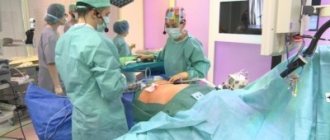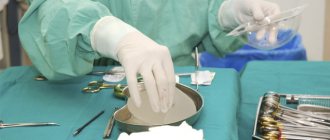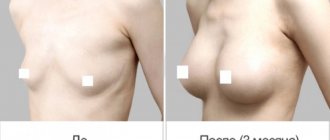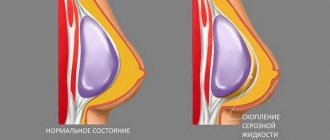Technique for performing abdominoplasty:
Abdominoplasty is performed under general anesthesia. Its duration depends both on the volume of the operation ( miniabdominoplasty or extended abdominoplasty ) and on the combination of abdominoplasty with additional abdominal modeling techniques ( liposuction of the lateral flanks of the abdomen, suturing of diastasis or removal of an abdominal hernia ). Generally, the operation time is from 2.5 to 4 hours.
The length of the incision during abdominoplasty directly depends on the excess skin on the abdomen and fatty tissue to be removed during surgery. A horizontal incision will be made in the suprapubic, iliac regions down to the lateral surfaces of the abdomen. When performing a miniabdominoplasty, the incision is not large and is located in the suprapubic region.
After the incision, the skin and subcutaneous fat are removed down to the lower edges of the costal arches. The resulting excess skin-fat flap is cut off so that its remainder can be sutured to the edge of the wound above the pubis and iliac regions. In most cases, abdominoplasty moves the belly button to a new location; sometimes a new navel is formed. The subflap space is drained by tubes for the outflow of blood and serous fluid. Abdominoplasty is often combined with abdominal liposuction to achieve the best cosmetic result.
After abdominoplasty, the patient spends 1-3 days in the clinic. The length of hospital stay depends on the extent of the operation, the patient’s well-being and is determined by the operating surgeon. In the first 2-3 days after abdominoplasty, pain in the abdominal area and muscle tension in the anterior abdominal wall are noted, so during this period the patient receives painkillers and, in some cases, antibacterial drugs. On the second day, the patient begins to wear compression stockings to prevent swelling of the lower extremities. Then, after examination by a doctor and dressing, you can leave the clinic for rehabilitation at home.
General problems
Abdominoplasty is a full-fledged operation. And it is characterized by all the problems provoked by surgical intervention in the body, the patient’s stay under general anesthesia, and the need to heal injured tissues. These are common complications. Their risk is higher in those who have health problems other than a large belly, or who are severely overweight.
General complications occur quite rarely. But their influence on well-being is very great. They are more life-threatening than local ones.
Pulmonary edema
The risk of pulmonary edema after surgery is associated with a violation of the pulmonary circulation. After all, during the operation, blood vessels in the abdominal area are damaged. Because of this, the blood supply to the entire zone is disrupted, and the blood component penetrates into areas of the lungs. The medications used can also impair the functions of the respiratory organs. Some of them are able to change the relationship between intrapulmonary pressure and the same capillary indicator.
Signs of edema include:
- labored breathing;
- shortening the time between inhalations and exhalations;
- “threshing” heartbeat;
- dry cough followed by foam.
The complication develops in the early postoperative stage, and care is provided in the hospital. This includes the administration of sedatives, normalization of blood pressure and circulation, and inhalation through anesthesia equipment.
Intra-abdominal hypertension syndrome
Suturing the abdominal wall in combination with bleeding and other problems with the functioning of internal organs can lead to an increase in pressure in the abdominal cavity. The diaphragm turns out to be raised, all other parts of the zone are compressed. This is manifested by shortness of breath, tachycardia, impaired renal function (difficulty urinating), tension and stretching of the abdominal wall, and changes in the functioning of the central nervous system. The complication is similar in appearance to pulmonary edema, but a specialist will be able to differentiate one problem from another. The patient is treated in intensive care.
Pneumonia
After the operation, the patient is forced to remain on bed rest. There is no need to move much even after you are allowed to get up. This causes weakening of the lungs, as fluid stagnates in them. And favorable conditions for reproduction are created for pathogenic bacteria that get inside.
To avoid pneumonia, patients are given a prophylactic course of antibiotics . But the main thing after abdominoplasty is not to lie in bed and move whenever possible.
We recommend reading about abdominoplasty. You will learn about the types of abdominoplasty, stages of the operation, indications and contraindications for the procedure, and the rehabilitation period. And here is more information about which option to choose to tidy up your abdomen: abdominoplasty or liposuction.
Thromboembolism
Changes in blood circulation can be fatal not only to internal organs, but also to veins. Blood clots form in them, which threaten the movement of biological fluid throughout the body. After all, a blood clot can clog a vessel.
More often, life-threatening blood clots form in the veins of the lower extremities. Therefore, to prevent complications, wearing compression stockings before and for some time after surgery becomes a mandatory requirement.
Bleeding
The problem may occur during abdominoplasty or immediately after. The cause of bleeding is poor coagulation of biological fluid or medical error when a specialist does not properly fix damaged vessels. Removing excessive amounts of fat tissue can also cause complications.
Help is to stop the bleeding as quickly as possible. Otherwise, the patient may face serious kidney problems and anemia.
After abdominoplasty:
After abdominoplasty, you will need to wear special compression garments for 30-60 days. If removable sutures are applied, they are removed within 8-14 days. Accordingly, with normal healing of a postoperative wound, dressings are required daily or every other day for two weeks. Starting from the third week after abdominoplasty, you can expand your physical activity.
Patients are shown observation by a cosmetologist and hardware methods of influencing both the “ripening” scar and the entire abdomen. This will help speed up recovery after surgery. If all recommendations are followed in the postoperative period, a thin white scar will remain at the incision site, hidden by underwear. The final result after abdominoplasty can be assessed after six months.
Reviews of unsuccessful abdominoplasty
Abdominoplasty is a rather serious operation that requires a competent choice of specialist. If you entrust abdominoplasty to a surgeon who does not have the necessary experience, the consequences may not be encouraging. Many men and women are satisfied with the changed appearance of their abdominal wall, but there are also those who are negatively opposed to the operation due to their sad experience.
“I was going to have an abdominoplasty for a very long time, because after a sharp weight loss, my stomach became like a fold that could not be removed. The operation went well and I was home on the third day. Difficulties appeared around the fifth day, when liquid began to leak from the seam. I went to the doctor, they did drainage, and instead of the promised two weeks of wound healing, I went to dressings for two months. The result is that the stomach has become almost flat, but the scar looks terrible - it is thick and red, the only plus is under clothes. The surgeon suggests excision of the scar, but I’m unlikely to dare to do it” - Lyubov, 41 years old.
“A distended stomach worsened my mood, especially in the summer, when I wanted to wear a fashionable thing. I saved up money for the operation and chose a clinic. At first it seemed that everything went well, but on the second day the suture area began to hurt very much, and a noticeable infiltration appeared. During the dressing, it was clear that the seams began to come apart, the doctor installed a drainage. There was swelling of the abdominal wall for a long time, pain bothered me, and it was difficult to straighten up. Now the recovery process is underway and although six months have passed since the abdominoplasty, I am not happy with the result yet” - Lisa, 37 years old.
Complications after abdominoplasty:
Any surgical intervention is associated with a certain risk of complications. Their development can be significantly reduced by carefully following the doctor’s recommendations in the pre- and postoperative period. Particular consideration should be given to the need to perform surgery in patients with concomitant diseases and smokers, as this is associated with an increased risk of complications. However, some of the possible complications are genetic and highly individual. Therefore, a qualified plastic surgeon will always tell you about the possible consequences during the preliminary consultation.
Among the complications of the early postoperative period, the appearance of hematomas and seromas is possible. To prevent them, drainage tubes are installed during abdominoplasty. In some cases, residual serous fluid can later be removed by puncture with a syringe through the skin. Wearing compression garments prevents the formation of seromas.
Excess scarring may develop at the incision site when the patient tends to develop hypertrophic or keloid scars. To prevent excessive scarring in the postoperative period after removal of sutures, it is necessary to rub in anti-scarring medications that the doctor will recommend to you.
How to prepare for surgery?
First of all, the patient must personally consult with the doctor who will operate on him. It is very important that the plastic surgeon carefully examines all the needs and desires of his patient. When this does not happen, the work has to be redone, because the doctor may not do exactly what the patient would like.
The doctor must also carefully study all tests obtained before the operation, which can confirm processes that prohibit abdominoplasty. It is very important that the therapist confirms that the patient is in good health and can undergo this plastic surgery. What tests need to be done before abdominoplasty? The therapist directs the patient to:
- general analysis of urine and blood;
- blood biochemistry;
- comprehensive analysis of blood clotting indicators;
- blood test for the presence of viral markers;
- electrocardiogram;
- chest x-ray;
- fluorography.
These are mandatory tests, but in each case the therapist may prescribe an additional examination. If there are no contraindications to plastic surgery, then at the next stage the patient should undergo a consultation with an anesthesiologist.
The date of the operation is determined exclusively by the plastic surgeon. Until this time, you should stop smoking and drinking alcoholic beverages, as well as taking medications that can thin the blood.
It is very important to follow the principles of proper nutrition. On the day of surgery, you can only have a light breakfast. Doctors allow you to drink only water, and then in limited quantities.
Three weeks after surgery
Another week has flown by, my stomach is only getting prettier. I took off all the diapers and only wore the bandage itself. After the shower, most of the crusts fell off along with the glue, leaving the largest crust at the junction with the vertical seam. Natalya Petrovna recommended using the Mepiform patch so that the scar would be thin and pale. The tummy began to peel, itches periodically in the navel area and there is swelling below, there is no sensitivity there at all. I limit myself in physical activity; I don’t lift anything heavier than a cat. Although I feel energetic and energetic, I really like my new tummy, now I have a waist
3.Indications and contraindications
The most widespread, although not the only category of patients are women with postpartum body transformation. Minimally invasive liposuction (removal of subcutaneous fat) in itself is not able to eliminate sagging and wrinkles on the skin, all kinds of folds and stretch marks, “apron” syndrome, “gloomy navel” (a roller hanging over the navel, giving the umbilical fold the appearance of a sad smiley face) and “double belly” "(skin and fat sagging both above and below the navel), not to mention umbilical hernias or rough old postoperative scars, which are also often corrected as part of abdominoplasty.
The main contraindications include:
- endocrine disorders (primarily diabetes mellitus);
- severe chronic diseases of the kidneys, stomach, liver and other visceral (internal) organs;
- hematological disorders (low blood coagulation, since blood loss may be unreasonably large, as well as too high coagulation, since it is fraught with thrombosis during the rehabilitation period).
About our clinic Chistye Prudy metro station Medintercom page!
1.General information
The general term “plastics” in surgery refers to a group of surgical techniques aimed at correcting, restoring or giving the desired shape to any organ or part of the human body. In the public consciousness, plastic surgery is firmly associated with aesthetic medicine (for example, facial skin lifting, correction of the shape of lips, nose, and many others are widely known), although in reality it is by no means limited to cosmetic operations. The same methodology is applied, in particular, in clinical abdominal interventions, when it is necessary to eliminate a birth defect or the consequences of a severe injury, reconstruct the normal anatomy of the affected organ, or restore the free flow of biological fluids.
Abdominoplasty (plastic surgery on the abdominal wall) is, as a rule, purely cosmetic; the ultimate goal is to recreate, and sometimes literally sculpture, the so-called. “flat stomach”, coveted and deified by the bodily fashion of recent decades. Abdominoplasty is often confused with liposuction, but these are different procedures, there are fundamental differences between them, and the second most often becomes part of the first.
A must read! Help with treatment and hospitalization!
Slow healing
For one reason or another, postoperative wounds sometimes heal slowly. Where the seam is located, the skin turns blue and a crust forms. Slow wound healing occurs:
- if during the operation the surgeon greatly stretched the skin;
- if the patient is a heavy smoker;
- due to individual characteristics of blood flow.
In case of deep tissue necrosis (this rarely happens), the doctor corrects the secondary scar area in order to improve the aesthetic appearance of the patient’s figure.
Edema
For example, in the early period after surgery, abdominal edema (or seroma) may appear. We are talking about the accumulation of lymph in the operating area. Typically, seromas form in the lower abdomen. When palpated, the liquid often flows from one side to the other. This phenomenon is explained by the fact that the subcutaneous space after surgery has empty zones. They communicate with each other, but then they heal and disappear. Seroma is a common phenomenon, but temporary, and there is no need to be afraid of it.
When a patient develops a seroma, the doctor’s task is to ensure that the subcutaneous cavities shrink as quickly as possible. For this purpose, several thin plastic tubes are placed under the skin. Each of them has a container at the end to collect liquid. The patient must wear a bandage that gently “presses” on the surgical area. This way the cavities will shrink faster and return to normal.
Five weeks
Time flies - baby is 5 weeks old today! At night I sleep without a bandage, in the morning I put it on, I feel more and more confident, I can sneeze fully. I don’t lift heavy things until I can’t until 3 months. The swelling still persists, it waxes and wanes, and the stomach changes in shape and sensation throughout the day. It can be soft, it can be like stone inside. There is sensitivity not everywhere, I stroke him and don’t understand where. I also feel qualitative changes in my life - my husband began to treat me more kindly, I began to notice signs of attention from him, which is nice, of course.
My belly button lost weight on one side, so I decided to make a collage in dynamics. This is how my tummy and my donut belly button have changed over these weeks.











